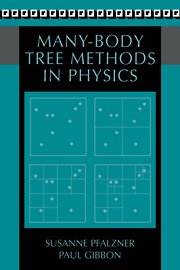Book contents
- Frontmatter
- Contents
- Preface
- Errata
- 1 Introduction
- 2 Basic Principles of the Hierarchical Tree Method
- 3 Open Boundary Problems
- 4 Optimisation of Hierarchical Tree Codes
- 5 Periodic Boundary Conditions
- 6 Periodic Boundary Problems
- 7 The Fast Multipole Method
- Appendix 1 Multipole Expansion in Two Dimensions
- Appendix 2 Spherical Harmonics
- Appendix 3 Near-Neighbour Search
- Refrences
- Index
7 - The Fast Multipole Method
Published online by Cambridge University Press: 11 September 2009
- Frontmatter
- Contents
- Preface
- Errata
- 1 Introduction
- 2 Basic Principles of the Hierarchical Tree Method
- 3 Open Boundary Problems
- 4 Optimisation of Hierarchical Tree Codes
- 5 Periodic Boundary Conditions
- 6 Periodic Boundary Problems
- 7 The Fast Multipole Method
- Appendix 1 Multipole Expansion in Two Dimensions
- Appendix 2 Spherical Harmonics
- Appendix 3 Near-Neighbour Search
- Refrences
- Index
Summary
In previous chapters we occasionally referred to an alternative type of tree code, namely the Fast Multipole Method (FMM). This technique, an elegant refinement of the basic Barnes–Hut algorithm, appears to be best suited to ‘static’ problems, where the particle distribution is more or less uniform. Although it has not been as widely used as the Barnes–Hut (BH) method for dynamic problems – because of either its increased mathematical complexity or the additional computational overhead – it may well become the basis of ‘multimillion’ N-body problems in the near future. We therefore include an introduction to FMM here, based primarily on works by Greengard (1987, 1988, 1990) and Schmidt and Lee (1991). At the same time, we will try to maintain a consistency of notation with the Barnes–Hut algorithm (hereafter referred to as the ‘tree method’ or ‘tree algorithm’), as described in Chapter 2.
Outline of the Fast Multipole Algorithm
The Fast Multipole Method makes use of the fact that a multipole expansion to infinite order contains the total information of a particle distribution. As in the BH algorithm, the interaction between near neighbours is calculated by direct particle–particle force summation, and more distant particles are treated separately. However, the distinction between these two contributions is obtained in a different way. In FMM the distant region is treated as a single ‘far-field’ contribution, which is calculated by a high-order multipole expansion.
The FMM was first formulated by Greengard and Rokhlin (1987).
- Type
- Chapter
- Information
- Many-Body Tree Methods in Physics , pp. 126 - 148Publisher: Cambridge University PressPrint publication year: 1996

